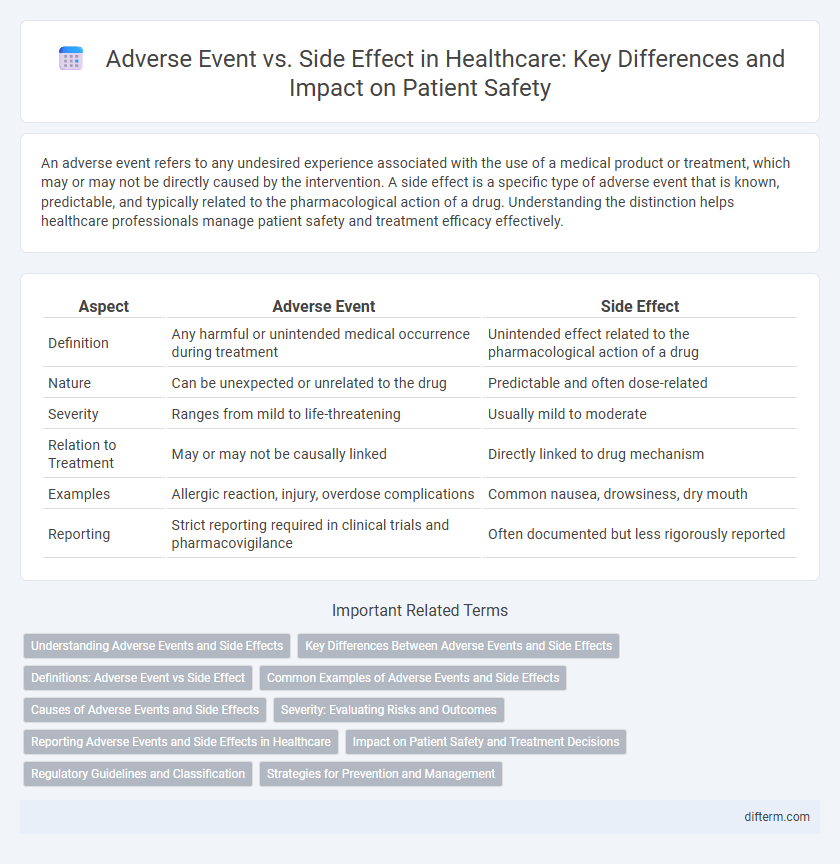An adverse event refers to any undesired experience associated with the use of a medical product or treatment, which may or may not be directly caused by the intervention. A side effect is a specific type of adverse event that is known, predictable, and typically related to the pharmacological action of a drug. Understanding the distinction helps healthcare professionals manage patient safety and treatment efficacy effectively.
Table of Comparison
| Aspect | Adverse Event | Side Effect |
|---|---|---|
| Definition | Any harmful or unintended medical occurrence during treatment | Unintended effect related to the pharmacological action of a drug |
| Nature | Can be unexpected or unrelated to the drug | Predictable and often dose-related |
| Severity | Ranges from mild to life-threatening | Usually mild to moderate |
| Relation to Treatment | May or may not be causally linked | Directly linked to drug mechanism |
| Examples | Allergic reaction, injury, overdose complications | Common nausea, drowsiness, dry mouth |
| Reporting | Strict reporting required in clinical trials and pharmacovigilance | Often documented but less rigorously reported |
Understanding Adverse Events and Side Effects
Adverse events refer to any unintended and harmful occurrences during medical treatment, which may or may not be directly caused by the drug or intervention. Side effects are specific types of adverse events that are known, predictable, and typically related to the pharmacological action of the medication. Differentiating between adverse events and side effects is crucial for accurate drug safety monitoring and patient care optimization.
Key Differences Between Adverse Events and Side Effects
Adverse events refer to any unintended and harmful occurrences during medical treatment, including unexpected symptoms or complications, while side effects are known, predictable, and often documented reactions to a medication or therapy. Key differences include that adverse events may arise from errors, allergies, or interactions, whereas side effects are typically dose-dependent and listed in drug information. Understanding these distinctions is essential for accurate diagnosis, patient safety, and effective management of treatment outcomes.
Definitions: Adverse Event vs Side Effect
An adverse event refers to any unintended and harmful occurrence experienced during or after medical treatment, which may or may not be caused by the treatment itself. A side effect is a specific type of adverse event that is a known, predictable, and often unavoidable outcome directly related to the pharmacological action of a medication or therapy. Understanding the distinction between adverse events and side effects is crucial for accurate patient monitoring and drug safety assessment in clinical practice.
Common Examples of Adverse Events and Side Effects
Common adverse events in health include allergic reactions, infections, and unexpected hospitalizations, which may occur during treatment but are not necessarily caused by the medication itself. Side effects frequently reported with medications include nausea, headache, dizziness, and fatigue, typically resulting directly from the drug's pharmacological action. Understanding the distinction and examples of each helps healthcare providers monitor patient safety and manage treatment effectively.
Causes of Adverse Events and Side Effects
Adverse events often result from unintended reactions to medications, medical procedures, or diagnostic tests, influenced by factors such as patient genetics, drug interactions, and dosage errors. Side effects are typically predictable outcomes directly caused by the pharmacological action of a drug, often documented during clinical trials and post-marketing surveillance. Identifying underlying causes involves analyzing patient history, drug properties, and environmental influences to differentiate between adverse events and side effects accurately.
Severity: Evaluating Risks and Outcomes
Adverse events encompass a wide range of health incidents that occur during or after medical treatment, varying significantly in severity from mild to life-threatening, whereas side effects are typically predictable and less severe reactions directly linked to the treatment. Evaluating the severity of adverse events involves assessing the impact on patient health, including hospitalization, disability, or death, while side effects usually involve manageable symptoms that do not require emergency intervention. Understanding the differences in severity helps healthcare providers balance treatment benefits against risks, ensuring informed decision-making and patient safety.
Reporting Adverse Events and Side Effects in Healthcare
Adverse events and side effects are critical components in healthcare safety monitoring, with adverse events referring to any unintended harm during medical treatment, while side effects specifically denote known, expected reactions to a medication. Accurate reporting of adverse events and side effects is essential for healthcare providers to identify risks, improve patient outcomes, and ensure regulatory compliance. Implementing standardized reporting systems like the FDA's MedWatch enhances data collection and supports ongoing pharmacovigilance efforts.
Impact on Patient Safety and Treatment Decisions
Adverse events encompass any unintended harm resulting from medical care, significantly impacting patient safety by potentially causing severe complications or prolonged hospitalization. Side effects are specific, often predictable reactions to a drug that influence treatment decisions by necessitating dosage adjustments or alternative therapies. Understanding the distinction improves clinical risk assessment and enhances patient outcomes by tailoring interventions to minimize harm.
Regulatory Guidelines and Classification
Regulatory guidelines distinguish adverse events as any untoward medical occurrences during treatment, regardless of causality, while side effects specifically refer to known, expected pharmacological reactions. Classification systems mandated by bodies like the FDA and EMA require adverse events reporting to monitor drug safety post-marketing, ensuring comprehensive pharmacovigilance. Clear differentiation between the two terms guides healthcare professionals in documentation, risk assessment, and regulatory compliance for patient safety.
Strategies for Prevention and Management
Effective strategies for preventing adverse events and side effects include thorough patient assessment, accurate medication reconciliation, and continuous monitoring during treatment. Implementing standardized protocols and utilizing electronic health records enhance early detection and timely intervention. Education and communication among healthcare providers and patients play a crucial role in minimizing risks and managing complications safely.
Adverse event vs Side effect Infographic

 difterm.com
difterm.com